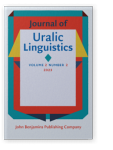Vol. 2:2 (2023) ► pp.158–193
On the syntax of postpositional phrases in Mari
Choosing between two structures
The paper discusses the syntax of postpositional constructions in Meadow Mari (Uralic, Morkinsko-Sernur dialect; head-final, SOV). Building upon existing approaches to postpositions in the world’s languages, I propose that PPs in Mari may have one of two underlying structures depending on the nature of the dependent but not on the nature of the adposition. PPs with a pronominal dependent involve possession between the Ground and a location nominal. In PPs with a non-pronominal dependent the Ground is merged directly into the complement position of a P head. I further expand the dataset and show that the two configurations successfully capture the distribution of reflexive pronouns in PPs. The proposed analysis accounts for all the relevant data: examples with independent and affixal postpositions and referential and pronominal dependents.
Article outline
- 1.Introduction
- 1.1Overview
- 1.2Data and methodology
- 1.3The structure of the paper
- 2.Postpositional constructions in Mari
- 2.1Basics of Mari morphosyntax
- 2.2Independent and affixal postpositions in Mari
- 2.3The morphosyntax of PPs with various types of dependents
- 2.3.1Postpositions with personal pronouns
- 2.3.2Postpositions with non-possessed referential expressions
- 2.3.3Postpositions with possessed referential expressions
- 2.3.4Interim summary
- 3.PPs as possessive constructions
- 3.1Components of the PP structure
- 3.2PPs with personal pronouns as possessive constructions
- 3.2.1Possession in Mari
- 3.2.2The Ground-location possessive relation in PPs with an independent adposition
- 3.2.3The Ground-location possessive relation in dative PPs
- 4.PPs with P0 taking Ground as a complement
- 4.1PPs with a referential dependent: No location
- 4.2PPs with a possessed nominal
- 5.On the optionality of POSS
- 6.Expanding the dataset: PPs with reflexives
- 7.Conclusion
- Acknowledgements
- Notes
-
References
For any use beyond this license, please contact the publisher at [email protected].
